#Data Visualization Service Providers
Explore tagged Tumblr posts
Text
Top Data Visualization Service Providers for Actionable Insights Looking for data visualization service providers to transform your raw data into clear, actionable insights? Discover top providers offering customized solutions to help you make data-driven decisions, enhance business performance, and communicate complex information effectively.
0 notes
Text
In today's digital landscape, data is a vital business asset. This presentation explores how Data Engineering Services transform raw, chaotic data into actionable insights. Learn why modern businesses must embrace scalable, AI-ready data solutions to drive smarter decisions, enhance customer experiences, ensure compliance, and fuel innovation through advanced technologies.
#Data Engineering Service#Data Visualization Services#Data Analytics and Visualization Services#Data Analysis Service Providers#Data Engineering
0 notes
Text
How to Optimize Data Management for a Seamless Digital Transformation and ERP Implementation?
Digital transformation and ERP (Enterprise Resource Planning) strategies have become pivotal for businesses aiming to stay competitive in today’s fast-evolving landscape. At the core of these strategies lies data management — a critical aspect that ensures accurate, reliable, and actionable insights for decision-making.
Watch this comprehensive video on starting data management in your ERP strategy for an in-depth understanding.
youtube
If you’re wondering how to start data management in your digital transformation and ERP strategy, this guide provides actionable steps to help you begin your journey effectively.
Why Data Management is Crucial in Digital Transformation
Before diving into the “how,” it’s essential to understand the “why.” Here’s why data management is indispensable:
Data as the Backbone of ERP Systems: ERP systems thrive on clean, structured, and well-organized data. Without proper data management, the efficiency of ERP systems diminishes.
Informed Decision-Making: Reliable data leads to better analytics, which fuels strategic decisions.
Cost Optimization: Effective data management reduces redundancies, eliminates errors, and cuts costs in operations.
5 Steps to Start Data Management in Your Digital Transformation Journey
1. Assess Your Current Data Landscape
Before implementing any strategy, audit your current data repositories. Identify duplicate, incomplete, or irrelevant data that might be affecting your systems.
2. Define Your Data Governance Framework
A strong governance framework ensures consistency and accountability. This includes setting rules for data collection, usage, storage, and security.
3. Choose the Right Tools and Technologies
Invest in master data management (MDM) tools that integrate seamlessly with your ERP system. These tools enable:
Centralized data storage
Automated data cleansing
Real-time data updates
4. Involve Key Stakeholders
Data management isn’t an IT-only responsibility. Include leaders from finance, operations, and supply chain departments to ensure holistic alignment.
5. Provide Continuous Training
Educate your employees about the importance of clean data and how their inputs impact larger systems like ERP. A data-driven culture begins with informed employees.
How ERP Systems and Data Management Work Hand-in-Hand
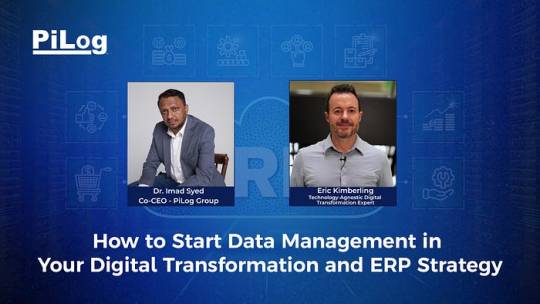
High-Impact Benefits of Starting Data Management Now
Enhanced Business Agility: With structured data, businesses can respond quickly to changes.
Improved Compliance: Regulatory requirements like GDPR and CCPA demand clean and transparent data practices.
Better Customer Experiences: When your systems are fueled by high-quality data, you deliver superior services.
Conclusion
Starting your data management journey may seem daunting, but with the right approach and resources, it can transform your digital transformation and ERP strategy into a powerful business enabler.
To gain deeper insights and actionable advice on this topic, make sure to watch this detailed video here.
Take the first step today — because the future of your business depends on how well you manage your data today!
#digital transformation#data management in erp#erp services#piloggroup#data analytics#data governance#erp solutions provider#data visualization#data visualisation#youtube#data scientist#data management solutions#datadriven#Youtube
0 notes
Text
Unlocking Insights with Cutting-Edge Big Data Analytics Services
In today's data-driven world, businesses generate vast amounts of information every second. Harnessing the power of this data is crucial for making informed decisions, gaining a competitive edge, and driving innovation. techcarrot's Big Data Analytics Services in Dubai and globally are designed to transform raw data into actionable insights, empowering your organization to thrive in the digital era.
Key Features:
· Data Integration and Aggregation:
Seamlessly integrate data from disparate sources.
Aggregate structured and unstructured data for a comprehensive view.
· Advanced Analytics:
Employ machine-learning algorithms for predictive analytics.
Identify patterns, trends, and anomalies for strategic decision-making.
· Scalable Infrastructure:
Utilize robust, scalable infrastructure to handle massive datasets.
Ensure performance and reliability, even with increasing data volumes.
· Real-time Analytics:
Enable real-time data processing for instant insights.
Quickly respond to changing market conditions and customer behavior.
· Data Security and Compliance:
Implement robust security measures to protect sensitive information.
Make sure that data protection regulations and industry standards are being followed.
Benefits:
Enhanced Decision-Making:
Make data-driven decisions backed by accurate and timely insights.
Improve strategic planning and resource allocation.
Operational Efficiency:
Streamline processes and operations through data optimization.
Identify and eliminate bottlenecks for improved efficiency.
Competitive Advantage:
Stay ahead of the competition with insights that drive innovation.
Identify emerging trends and market opportunities.
Customer Satisfaction:
Understand customer behavior and preferences.
Personalize offerings and enhance the overall customer experience.
Industries we serve:
Finance: Analyze market trends, manage risks, and optimize investment strategies.
Healthcare: Improve patient outcomes, streamline operations, and enhance healthcare delivery.
Retail: Optimize inventory, personalize marketing, and improve customer engagement.
Manufacturing: Enhance supply chain efficiency, predict maintenance needs, and improve quality control.
Why choose techcarrot for Big Data Analytics Services?
Expertise: Our team of seasoned data scientists and analysts brings extensive experience to the table.
Custom Solutions: Tailored analytics solutions to meet the unique needs of your business.
Scalability: Grow with confidence, knowing our solutions can scale with your evolving data requirements.
Client Success Stories: Discover how our services have transformed businesses in industry.
Get started today! Embrace the power of data with our big Data Analytics Services. Contact us to schedule a consultation and unlock the full potential of your data.
Check out our previous blogs:
Information Technology Consulting Service Middle East
🚀 Empower Your Business with Microservices Application Development Services!
Empowering Your Vision: Leading Mobile App Development Company
#data visualization services in dubai#big data consulting services in dubai#data intelligence company dubai#data intelligence service providers in dubai#big data#data#data analytics
0 notes
Text
SAP Implementation Services
SAP Implementation Services
Samah offers comprehensive SAP Implementation and Support Services. Their expert team counsels develops and maintains customized SAP solutions. It's a one-stop solution for multiple business functions. SAP collects, stores, and processes data across business applications and functions in one simplified platform. For more SAP services like SAP HANA S/4 on public cloud, SAP S/4 HANA Cloud Application implementation, Rise with SAP implementation, Grow with SAP implementation, BI, BO, Analytics, Data Visualization, S/4 HANA Cloud Upgrade, SAP Successfactor, SAP Annual Maintenance Service, and SAP AMS service provider.
#sap services#sap implementation#SAP Annual Maintenance Service#SAP AMS service provider#SAP Successfactor#SAP HANA S/4 on public cloud#SAP S/4 HANA Cloud Application implementation#Rise with SAP implementation#S/4 HANA Cloud Upgrade#BI#BO#Analytics#Data Visualization#Grow with SAP implementation
1 note
·
View note
Text
Conspiratorialism as a material phenomenon

I'll be in TUCSON, AZ from November 8-10: I'm the GUEST OF HONOR at the TUSCON SCIENCE FICTION CONVENTION.

I think it behooves us to be a little skeptical of stories about AI driving people to believe wrong things and commit ugly actions. Not that I like the AI slop that is filling up our social media, but when we look at the ways that AI is harming us, slop is pretty low on the list.
The real AI harms come from the actual things that AI companies sell AI to do. There's the AI gun-detector gadgets that the credulous Mayor Eric Adams put in NYC subways, which led to 2,749 invasive searches and turned up zero guns:
https://www.cbsnews.com/newyork/news/nycs-subway-weapons-detector-pilot-program-ends/
Any time AI is used to predict crime – predictive policing, bail determinations, Child Protective Services red flags – they magnify the biases already present in these systems, and, even worse, they give this bias the veneer of scientific neutrality. This process is called "empiricism-washing," and you know you're experiencing it when you hear some variation on "it's just math, math can't be racist":
https://pluralistic.net/2020/06/23/cryptocidal-maniacs/#phrenology
When AI is used to replace customer service representatives, it systematically defrauds customers, while providing an "accountability sink" that allows the company to disclaim responsibility for the thefts:
https://pluralistic.net/2024/04/23/maximal-plausibility/#reverse-centaurs
When AI is used to perform high-velocity "decision support" that is supposed to inform a "human in the loop," it quickly overwhelms its human overseer, who takes on the role of "moral crumple zone," pressing the "OK" button as fast as they can. This is bad enough when the sacrificial victim is a human overseeing, say, proctoring software that accuses remote students of cheating on their tests:
https://pluralistic.net/2022/02/16/unauthorized-paper/#cheating-anticheat
But it's potentially lethal when the AI is a transcription engine that doctors have to use to feed notes to a data-hungry electronic health record system that is optimized to commit health insurance fraud by seeking out pretenses to "upcode" a patient's treatment. Those AIs are prone to inventing things the doctor never said, inserting them into the record that the doctor is supposed to review, but remember, the only reason the AI is there at all is that the doctor is being asked to do so much paperwork that they don't have time to treat their patients:
https://apnews.com/article/ai-artificial-intelligence-health-business-90020cdf5fa16c79ca2e5b6c4c9bbb14
My point is that "worrying about AI" is a zero-sum game. When we train our fire on the stuff that isn't important to the AI stock swindlers' business-plans (like creating AI slop), we should remember that the AI companies could halt all of that activity and not lose a dime in revenue. By contrast, when we focus on AI applications that do the most direct harm – policing, health, security, customer service – we also focus on the AI applications that make the most money and drive the most investment.
AI hasn't attracted hundreds of billions in investment capital because investors love AI slop. All the money pouring into the system – from investors, from customers, from easily gulled big-city mayors – is chasing things that AI is objectively very bad at and those things also cause much more harm than AI slop. If you want to be a good AI critic, you should devote the majority of your focus to these applications. Sure, they're not as visually arresting, but discrediting them is financially arresting, and that's what really matters.
All that said: AI slop is real, there is a lot of it, and just because it doesn't warrant priority over the stuff AI companies actually sell, it still has cultural significance and is worth considering.
AI slop has turned Facebook into an anaerobic lagoon of botshit, just the laziest, grossest engagement bait, much of it the product of rise-and-grind spammers who avidly consume get rich quick "courses" and then churn out a torrent of "shrimp Jesus" and fake chainsaw sculptures:
https://www.404media.co/email/1cdf7620-2e2f-4450-9cd9-e041f4f0c27f/
For poor engagement farmers in the global south chasing the fractional pennies that Facebook shells out for successful clickbait, the actual content of the slop is beside the point. These spammers aren't necessarily tuned into the psyche of the wealthy-world Facebook users who represent Meta's top monetization subjects. They're just trying everything and doubling down on anything that moves the needle, A/B splitting their way into weird, hyper-optimized, grotesque crap:
https://www.404media.co/facebook-is-being-overrun-with-stolen-ai-generated-images-that-people-think-are-real/
In other words, Facebook's AI spammers are laying out a banquet of arbitrary possibilities, like the letters on a Ouija board, and the Facebook users' clicks and engagement are a collective ideomotor response, moving the algorithm's planchette to the options that tug hardest at our collective delights (or, more often, disgusts).
So, rather than thinking of AI spammers as creating the ideological and aesthetic trends that drive millions of confused Facebook users into condemning, praising, and arguing about surreal botshit, it's more true to say that spammers are discovering these trends within their subjects' collective yearnings and terrors, and then refining them by exploring endlessly ramified variations in search of unsuspected niches.
(If you know anything about AI, this may remind you of something: a Generative Adversarial Network, in which one bot creates variations on a theme, and another bot ranks how closely the variations approach some ideal. In this case, the spammers are the generators and the Facebook users they evince reactions from are the discriminators)
https://en.wikipedia.org/wiki/Generative_adversarial_network
I got to thinking about this today while reading User Mag, Taylor Lorenz's superb newsletter, and her reporting on a new AI slop trend, "My neighbor’s ridiculous reason for egging my car":
https://www.usermag.co/p/my-neighbors-ridiculous-reason-for
The "egging my car" slop consists of endless variations on a story in which the poster (generally a figure of sympathy, canonically a single mother of newborn twins) complains that her awful neighbor threw dozens of eggs at her car to punish her for parking in a way that blocked his elaborate Hallowe'en display. The text is accompanied by an AI-generated image showing a modest family car that has been absolutely plastered with broken eggs, dozens upon dozens of them.
According to Lorenz, variations on this slop are topping very large Facebook discussion forums totalling millions of users, like "Movie Character…,USA Story, Volleyball Women, Top Trends, Love Style, and God Bless." These posts link to SEO sites laden with programmatic advertising.
The funnel goes:
i. Create outrage and hence broad reach;
ii, A small percentage of those who see the post will click through to the SEO site;
iii. A small fraction of those users will click a low-quality ad;
iv. The ad will pay homeopathic sub-pennies to the spammer.
The revenue per user on this kind of scam is next to nothing, so it only works if it can get very broad reach, which is why the spam is so designed for engagement maximization. The more discussion a post generates, the more users Facebook recommends it to.
These are very effective engagement bait. Almost all AI slop gets some free engagement in the form of arguments between users who don't know they're commenting an AI scam and people hectoring them for falling for the scam. This is like the free square in the middle of a bingo card.
Beyond that, there's multivalent outrage: some users are furious about food wastage; others about the poor, victimized "mother" (some users are furious about both). Not only do users get to voice their fury at both of these imaginary sins, they can also argue with one another about whether, say, food wastage even matters when compared to the petty-minded aggression of the "perpetrator." These discussions also offer lots of opportunity for violent fantasies about the bad guy getting a comeuppance, offers to travel to the imaginary AI-generated suburb to dole out a beating, etc. All in all, the spammers behind this tedious fiction have really figured out how to rope in all kinds of users' attention.
Of course, the spammers don't get much from this. There isn't such a thing as an "attention economy." You can't use attention as a unit of account, a medium of exchange or a store of value. Attention – like everything else that you can't build an economy upon, such as cryptocurrency – must be converted to money before it has economic significance. Hence that tooth-achingly trite high-tech neologism, "monetization."
The monetization of attention is very poor, but AI is heavily subsidized or even free (for now), so the largest venture capital and private equity funds in the world are spending billions in public pension money and rich peoples' savings into CO2 plumes, GPUs, and botshit so that a bunch of hustle-culture weirdos in the Pacific Rim can make a few dollars by tricking people into clicking through engagement bait slop – twice.
The slop isn't the point of this, but the slop does have the useful function of making the collective ideomotor response visible and thus providing a peek into our hopes and fears. What does the "egging my car" slop say about the things that we're thinking about?
Lorenz cites Jamie Cohen, a media scholar at CUNY Queens, who points out that subtext of this slop is "fear and distrust in people about their neighbors." Cohen predicts that "the next trend, is going to be stranger and more violent.”
This feels right to me. The corollary of mistrusting your neighbors, of course, is trusting only yourself and your family. Or, as Margaret Thatcher liked to say, "There is no such thing as society. There are individual men and women and there are families."
We are living in the tail end of a 40 year experiment in structuring our world as though "there is no such thing as society." We've gutted our welfare net, shut down or privatized public services, all but abolished solidaristic institutions like unions.
This isn't mere aesthetics: an atomized society is far more hospitable to extreme wealth inequality than one in which we are all in it together. When your power comes from being a "wise consumer" who "votes with your wallet," then all you can do about the climate emergency is buy a different kind of car – you can't build the public transit system that will make cars obsolete.
When you "vote with your wallet" all you can do about animal cruelty and habitat loss is eat less meat. When you "vote with your wallet" all you can do about high drug prices is "shop around for a bargain." When you vote with your wallet, all you can do when your bank forecloses on your home is "choose your next lender more carefully."
Most importantly, when you vote with your wallet, you cast a ballot in an election that the people with the thickest wallets always win. No wonder those people have spent so long teaching us that we can't trust our neighbors, that there is no such thing as society, that we can't have nice things. That there is no alternative.
The commercial surveillance industry really wants you to believe that they're good at convincing people of things, because that's a good way to sell advertising. But claims of mind-control are pretty goddamned improbable – everyone who ever claimed to have managed the trick was lying, from Rasputin to MK-ULTRA:
https://pluralistic.net/HowToDestroySurveillanceCapitalism
Rather than seeing these platforms as convincing people of things, we should understand them as discovering and reinforcing the ideology that people have been driven to by material conditions. Platforms like Facebook show us to one another, let us form groups that can imperfectly fill in for the solidarity we're desperate for after 40 years of "no such thing as society."
The most interesting thing about "egging my car" slop is that it reveals that so many of us are convinced of two contradictory things: first, that everyone else is a monster who will turn on you for the pettiest of reasons; and second, that we're all the kind of people who would stick up for the victims of those monsters.

Tor Books as just published two new, free LITTLE BROTHER stories: VIGILANT, about creepy surveillance in distance education; and SPILL, about oil pipelines and indigenous landback.


If you'd like an essay-formatted version of this post to read or share, here's a link to it on pluralistic.net, my surveillance-free, ad-free, tracker-free blog:
https://pluralistic.net/2024/10/29/hobbesian-slop/#cui-bono

Image: Cryteria (modified) https://commons.wikimedia.org/wiki/File:HAL9000.svg
CC BY 3.0 https://creativecommons.org/licenses/by/3.0/deed.en
#pluralistic#taylor lorenz#conspiratorialism#conspiracy fantasy#mind control#a paradise built in hell#solnit#ai slop#ai#disinformation#materialism#doppelganger#naomi klein
308 notes
·
View notes
Text
Internet access is hanging on by a thread after most of Gaza’s telecommunication infrastructure was damaged or wiped out in Israeli airstrikes. The bombing campaign earlier this week��destroyed two of the three main lines for mobile communication, leaving just one line working, but with disrupted service. Overall, connectivity in the Gaza Strip has fallen from about 95% in early October to around 60% as of Friday morning, according to data from NetBlocks, an internet outage monitoring firm based in London. The lone provider standing between Palestinians and a total blackout is Paltel, the Palestine Telecommunications Company. While all nine of Gaza’s local internet service providers have effectively stopped working, Paltel is the largest Palestinian provider, with connections in the Gaza Strip and throughout the region. While currently enough of its cable network that supports fixed broadband and phone services remains intact, the company said it anticipates a “total blackout” if any more of its lines to Egypt or Israel are damaged.
Harder for people to document Israeli war crimes if there's no internet.
2K notes
·
View notes
Text
Hello. You might have seen this floating around on twt:


link 1 // link 2, archive link
If by any chance you or someone you know are thinking about joining in on the challenge… no one can stop you but I implore you as someone who makes art, as someone with friends in an often-exploited creative industry, as someone who lives in late stage capitalism alongside you and has seen this play out before: proceed with caution.
Read the fine print on that form. There is NO guarantee of an internship, much less a job at the end of it. I haven't gone further than this form, but if anyone reading this does, and if there's no written agreement that your work won't be used without credit to you + payment for services rendered - RUN.
This is a common corporate tactic to get free labor out of people. I'm not saying this is necessarily what’s happening; for all we know this was done as a completely innocent move to drum up some fan engagement and as a genuine search for talent for their analytics team. WHO KNOWS. But I can't ignore that I’ve seen this situation play out again and again, at every scale.
Job interviews, when they ask you how YOU think they should improve their systems, how YOU would solve their problems? When they require that you do some problem-solving for them, and it goes beyond a simple task? That’s a free consultation you’re giving them, that's free work you or someone else should be getting paid for.
When big streamers/influencers ask their fans to join in on a fan art contest to choose their new pfp/banner? That’s hundreds, possibly thousands of pieces of free art they never would’ve gotten otherwise. They could've gone to the trouble of paying someone in-house to do it, hiring someone for that position, commissioning a professional for a piece. It's free work from their dedicated fans.
In this case, Utah HC is asking fans to not only choose/provide their own dataset, but to do a complex analysis on it AND do the work of visual and verbal communication to senior management, who likely do not have a deeper grasp of the concepts and will need it simplified. The stipulation that you will present your work could be ANYTHING!! The "five page deliverable" is already bananas to me, having dipped my toe into what analytics is and how complex the fun ones are. Condensing it all is WORK. The presentation portion may include speaking time and answering questions; the groundwork for doing this effectively may include producing data visualisations, making spreadsheets, time consuming write-ups. Maths and science communication is hard. It is WORK. They are asking for free labor.
Many have already called it out, but it's still gaining traction via retweets from big accounts uncritically sharing it. I found out through the official Puckpedia account. Jack Han called it out pretty eloquently on twitter and on his substack:
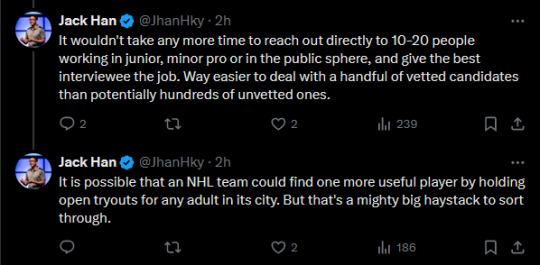
Many people aspire to work as an analyst in the NHL. Earlier today the Utah Hockey Club gave those people a glimmer of hope. Utah’s Summer Analytics Challenge is unusual in that it doesn’t provide a dataset or detailed instructions. The open-ended contests contrasts with other public (ex: Big Data Cup) or private (ex: NHL team interview) events. In those scenarios, participants are given proprietary data to clean, model and analyze, which influence direction and methodology. Meanwhile, Utah is seemingly happy with anything as long as the writeup is under five pages long. Utah’s contest also stands out in its near-total absence of legal fine print. There are no mention of intellectual property implications, which is perhaps fitting when the team is asking participants to bring their own data and analysis. [...] Open casting calls such as Utah’s analytics challenge start out as a lose-lose-lose proposition: > The employer loses because it will have to invest massive human resources to trawl/filter/evaluate/reverse-engineer the hundreds of write-ups it is sure to receive, with no guarantee that any of them will be of use > Applicants lose because the vast, vast majority of them will have nothing to show for their efforts, while a tiny minority risks having its IP stolen > Good ideas lose because they’ll be born into an environment where their parents (the applicant & the employer) have no defined relationship and won’t be in a position to grow together
link, archive link
I do try to keep things light on this blog, but this is super personal for me <3 thank u for listening
#so glad the majority of the reaction to this has been to shit on it tbqh. GET THEIR ASSES#TRYING OUT ADDING ARCHIVE LINKS WHEN I CAN !! FUCK WEBROT!!! AND FUCK THEM IF THEY TRY TO DELETE THE EVIDENCE!!!#Utah HC#Utah Hockey Club#puckposting
38 notes
·
View notes
Text
The recent installation of Elon Musk ally Thomas Shedd atop the federal IT structure has thrown an agency in charge of servicing much of the US government’s technical infrastructure into disarray.
Over the last few days, workers at the Technology Transformation Services (TTS), which is housed within the General Services Administration (GSA), have been summoned into what one source called “sneak attack” meetings to discuss their code and projects with total strangers—some quite young—who lacked official government email addresses and have been reticent to identify themselves. TTS workers have also received confusing transition guidance and a sudden DC office visit from Musk.
It was announced last week that Shedd, who previously worked as a software engineer for eight years at Tesla, Musk’s electric car company, would be the new TTS director. In emails to TTS staff, Shedd reinforced the Trump administration’s commitment to cutting costs and maximizing efficiency—something Musk’s Department of Government Efficiency, or DOGE, has been charged with carrying out.
“I’ve spent my entire career in Silicon Valley,” Shedd wrote in an introductory email to staff last Thursday and obtained by WIRED. “If we work together and execute well we will be able to navigate the policies, leverage our technical expertise and be a critical part of accelerating technology adoption across agencies to enable great gains in efficiency.”
TTS helps develop the platforms and tools that underpin many government services, including analytics tools and API plugins that agencies can use to deploy tech faster. This means that the group has access to troves of government data and systems across agencies. That access is useful for standardizing the many, not always interoperable, systems that the federal government uses, but could also provide invaluable information to a private company or be weaponized against government employees and citizens.
Early Wednesday morning, rumors began to spread at TTS that employees would be receiving surprise one-on-one meeting notifications from management. During these brief meetings, employees would, according to a staff email that Shedd sent later on Tuesday, be asked to identify their biggest “wins” and the most significant “blockers” preventing them from working as efficiently as possible. The email linked to a Google Form questionnaire for employees to fill out ahead of their scheduled meetings. The invites included people without official GSA email accounts who were using Gmail addresses as well as official government accounts, multiple sources told WIRED.
“These should be items that you completed,” a screenshot of the form obtained by WIRED said. “It is OK to have a mix of big projects and small wins (examples: fixed a critical bug, shipped XYZ feature, saved this amount on a renegotiated contract, ect [sic] … If you are an engineer or designer please include a link to a PR [pull request] or a screenshot of one of your wins from the past 3 months.”
The email is reminiscent of one that Musk sent early in his Twitter days, demanding that employees email a one-page description of what they had accomplished the previous month and how it differed from their goals.
Rather than convening with Shedd in these meetings, TTS employees were instead surprised to be met with people they had never seen or worked with before.
“It was a very confusing call because I expected to be meeting you, and I was instead met by two people reluctant to identify themselves,” one TTS employee told Shedd in an open Slack channel, one of several reviewed by WIRED. “They had not seen the information I submitted in my form, so I was left trying to explain things without the visuals/links I had submitted,” one wrote.
“Also had the same exact experience,” another employee added. “The individual I had met with had no idea about the google form I submitted and when I did reference it, I was met with avoidance.”
In a Slack message to TTS staff on Thursday morning viewed by WIRED, Shedd apologized for the vague and sudden meeting invites, and for including unnamed individuals in the meetings who joined with Gmail addresses.
“They are each in the onboarding process of obtaining a GSA laptop and PIV card. I take full responsibility for the actions of each of them in the calls. I’ve asked them to start the calls with their first name and confirming that they are an advisor to me,” Shedd said in a screenshot of the Slack message viewed by WIRED.
Shedd told employees that the people on the calls were “vetted by me, and invited into the call.” He said they were physically present with him at the GSA headquarters, and that he had “badged them all into the building.” This implies that those joining the calls did not currently have official government IDs issued to agency staff.
At least two of these individuals appeared to be “college students with disturbingly high A-suite clearance,” one TTS source told WIRED. (A-suite clearances tie employees to the GSA administrator’s office.)
One person says they were brought into a review with Edward Coristine, a recent high school graduate who spent several months at Neuralink, Musk’s brain-computer interface company, whom WIRED has previously identified as a person working at the Office of Personnel Management (OPM) and reporting directly to its new chief of staff, the former xAI employee Amanda Scales. He has not responded to requests for comment from WIRED, and OPM has declined to comment.
“We do not have any additional personnel announcements at this time.” a GSA spokesperson told WIRED on Thursday.
It’s typical for TTS workers to work in tandem with other agencies across government, with many of their projects containing data external to GSA and subject to sensitivity agreements. Being required to share specific technical achievements, though, spooked some employees who feared they could breach these agreements.
“The team is correct in feeling nervous sharing details about other agencies in these calls and should continue to follow the normal guidance which is to not share sensitive information,” Shedd wrote in the GSA Slack on Thursday. “The point of these calls is to talk through interesting example problems/wins and dig into how that win was realized. A chance for you to brag about how you solved a problem.”
This week, it appears that TTS has become the primary target of these meetings, but members of the US Digital Services—which a Trump executive order has rebranded as Musk’s DOGE—also met with management to go over their recent work last week. The DOGE meetings were conducted similarly in structure to the TTS ones, according to The Washington Post.
Like many other agencies, GSA has been making changes to DEI initiatives that have put workers on edge. On January 23, TTS deputy director Mukunda Penugonde announced that as part of the GSA’s new initiative to curtail DEIA programs, the agency would be shutting down its “Diversity Guild meeting series” and the “#g-diversity Slack channel effective today,” in an email reviewed by WIRED.
Musk was seen at the GSA office near the White House on Thursday, but it’s unclear what he was doing there. Shedd was scheduled to lead a meeting with around 40 TTS program supervisors Thursday afternoon. On Wednesday, WIRED reported that Musk has been telling his friends that he’s been sleeping at the DOGE office in DC.
Of all parts of the government, TTS, perhaps even more so than DOGE, is well positioned to get inside agencies’ technology and data, including government spending data, explaining why it’s such a focus for the new administration.
“TTS represents the consolidation of 20-plus years of tech and data expertise, brought together by the hard work of hundreds (if not thousands) of civil servants,” Noah Kunin, a cofounder of 18F, a team of designers and engineers within the GSA that help government agencies build and deploy new tech products, and a former infrastructure director at GSA, tells WIRED. “They have the products, platforms, and people to do this work right, within the confines of current law, and fast.”
8 notes
·
View notes
Text
Connect Odoo with Tableau Desktop

The Techfinna Odoo Tableau Connector is a integration tool that connects Odoo with Tableau, enabling real-time data extraction and visualization. With features like custom table selection, automatic schema detection, and support for live data refresh, it simplifies the process of creating dynamic dashboards and reports. This connector empowers businesses to unlock deeper insights and make data-driven decisions efficiently.
#odoo #odooerp #odoosoftware #odoomodule #crm #accounting #salesforce #connector #integration #odoo18 #odoo17 #microsoft #powerbi #desktop #odoo services#odooimplementation#google#odoo development company#odoo crm#microsoft#odoo erp#odoo#good omens
#odoo erp#odoo18#odooimplementation#odoo development company#odoo services#analytics#innovation#cybersecurity#tableau#advanced#odoo#business
8 notes
·
View notes
Text




Final data and undiscovered images from NASA’s NEOWISE
While NASA’s NEOWISE telescope ended its journey through space on Nov. 1, 2024, the team at IPAC, a science center at Caltech, was working on one further gift from the prolific mission.
The final data release from NEOWISE was released to the astronomy community just two weeks later, on Nov. 14, encompassing over 26 million images and nearly 200 billion sources detected by the telescope. And today, IPAC is releasing six new images from the mission’s archival data as a tribute to this landmark project, available here: https://www.astropix.org/link/3b2x
NEOWISE was launched as the Wide-field Infrared Survey Explorer (WISE) in 2009 and then reactivated in 2013 as NEOWISE, the asteroid-hunting phase of the mission. The infrared space telescope studied the entire night sky and conducted 21 complete sky surveys during more than a decade of operation. The mission focused on identifying and studying small objects in our solar system like asteroids and comets, also known as near-Earth objects (NEOs), but the infrared data collected by the telescope has proven to have countless applications throughout the field of astronomy.
The mission concluded operations in July 2024, and during its 15 years in space, scientists have been able to revisit the same areas of the sky again and again, with most being observed by NEOWISE at least 220 times. This repeated observation helps astronomers search for and study objects that change in brightness or location.
“Being able to watch the changing sky for nearly 15 years has opened a new avenue for time-domain science, for everything from the closest asteroids to the most distant quasars,” said Joe Masiero, Research Scientist at IPAC and the Deputy Principal Investigator of the mission.
In recent years, NEOWISE has enabled scientists to study curious objects like brown dwarfs and discover patterns in large populations of comets. Over its mission lifetime, NEOWISE has characterized over 3000 NEOs—approximately 10% of the known population, and something that was only possible due to its long tenure scanning the sky.
The final NEO observed by NEOWISE, known as 2007 LV8, was seen over 100 times in the closing days of the survey since it closely followed the telescope’s scan pattern.
“Because of NEOWISE’s extensive view of the sky, we get a more complete picture of the asteroids and comets in Earth’s orbital neighborhood. The data provide a unique way of understanding factors like the size and rotation period of these NEOs,” said Roc Cutri, NEOWISE Task Lead and Project Scientist at IPAC.
The team at IPAC was responsible for the ingestion and processing of raw data, production of final data products, and archiving mission science and engineering data. IPAC also distributes WISE/NEOWISE data to the community through the NASA/IPAC Infrared Science Archive (IRSA) and provides services such as powerful analysis and visualization tools. The IPAC Communications & Education team prepares mission images for public release in the AstroPix image gallery.
Never-before-seen images from NEOWISE
During the original WISE mission, over 100 areas of the sky were highlighted in public image releases, but they revealed only a tiny fraction of the full-sky coverage of the survey.
“The WISE and NEOWISE data releases are built for researchers, but they also embody some of the most amazing images of our infrared sky,” said Robert Hurt, IPAC Visualization Scientist. “They are so easy to work with it's almost too easy to make a beautiful image from them! That's why I wanted to revisit the archive to locate some hidden gems we missed before.”
To find new interesting areas of the sky, the positions of the previous images were overlaid onto maps of the sky using data from WISE and other missions. The new map revealed many zones that have not been highlighted for the public but contain fascinating regions of cosmic dust where stars are born. Six spots were selected, with many of them spanning large areas of the sky—a distinct advantage of an all-sky survey such as NEOWISE.
One image stands out as particularly meaningful to the IPAC community: NEOWISE’s view of the California Nebula.
Named after the dust cloud’s resemblance to the California coastline, Masiero says it commemorates the years of hard work and dedication of the NEOWISE data processing team at IPAC, located in Pasadena, California.
“I’m really grateful for all of the people at IPAC who have put so much effort into making this the best dataset possible, for today and for future generations,” said Masiero.
The California Nebula is located in the Milky Way, about 1000 light-years away, in the Perseus constellation. It is a dusty region illuminated by the nearby massive star Menkib, born just a few million years ago. The entire California Nebula stretches across 100 light-years and is fully captured in this wide-field view. The dust clouds glow brightly in longer wavelengths of infrared light, displayed here in green and red.
The new images pulled from the archives represent the billions of sources detected by NEOWISE waiting to be studied by future researchers.
“We know there are more things to discover in the NEOWISE data that we just haven’t noticed yet,” said Masiero. “As astronomers develop new tools and techniques and as new surveys are conducted, we can be sure the NEOWISE archive will be one of the first places we look for the data needed to better understand our universe.”
NEOWISE’s legacy is only just beginning
As astronomers continue to mine the NEOWISE archive at IRSA, there are many untold stories of comets, asteroids, nebulae, and more waiting in the data.
Yuna Kwon, a solar system astronomer and IPAC archive scientist, first joined as a postdoctoral fellow in 2023. Even though the NEOWISE mission ended not long after, her work with its data is only just beginning.
Along with Masiero, Kwon is leading a project called COSINE, Cometary Object Study Investigating their Nature and Evolution, cataloging and analyzing comets observed by NEOWISE.
“Together with my amazing colleagues at IPAC, we now have the largest-ever consistently analyzed comet database and are preparing publications based on our findings,” said Kwon.
Kwon studies comets because they are some of the oldest and most primitive objects in our solar system. Their physical properties could tell us about the conditions during the solar system’s formation.
“Comets are like cats — they have tails and do precisely what they want,” said Kwon. “Thankfully, NEOWISE has a treasure trove of data to study these idiosyncratic objects.”
Before working with NEOWISE data, Kwon said that it was hard to decipher large-scale trends from only a small number of comets. But now with COSINE and NEOWISE data, she is able to understand the big picture.
“I'm truly enjoying this exploration,” said Kwon. “My experience with NEOWISE data has broadened my perspective and deepened my understanding of the comet population itself, putting the observations in a broader context of the formation and evolution of the solar system.”
Going forward, Kwon hopes to combine the knowledge gained from NEOWISE with new data from upcoming observatories including NEO Surveyor and SPHEREx.
TOP IMAGE: The California Nebula is seen in its entirety in this image from NASA’s WISE mission, covering over 25 square degrees of sky. In this infrared view, the dust clouds underlying the nebula glimmer in greens and reds. Also known as NGC 1499, it derives its common name from its similarity to the dramatic coastline of the U.S. state of California.
The California Nebula extends 100 light years through space, and it is illuminated by one of the hottest stars visible in the night sky, known as Menkib. Its surface temperature is about 37,000 degrees, and its total energy output is over 300,000 times more than that of our own Sun. It belongs to an association of very hot stars that were born from the California Nebula only a few million years ago.
The stellar winds blowing out from the fast-moving Menkib pile up as they impact interstellar gas and dust to create a shock wave. Known a “bow shock,” as an analogy to the waves that pile up at the bow of a sailing ship, it heats up the ambient dust clouds through which it is passing, seen here in red.
This image uses data from the original cryogenic phase of the WISE mission. Infrared wavelengths of 3.4 & 4.6 microns are displayed in blue and cyan, respectively, and are dominated by the glow of stars. Light with a wavelength of 12 microns is displayed in green and traces the presence of carbon-rich dust known as polycyclic aromatic hydrocarbons (PAHs). The 22 micron light is rendered in red and is dominated by the thermal glow of warm dust.
Credit NASA/JPL-Caltech/IPAC
CENTRE IMAGE: Skygazers have dubbed this region the “Gecko Nebula” for its resemblance to a downturned head with a pointed snout, though astronomers refer to the area as LBN 437. This cloud of dust and gas is a region of star formation, which is revealed clearly in infrared light by NASA’s WISE mission.
Near the “snout” of the gecko you can see a blazing star with a strong red tint, due to its brightness at longer wavelengths of infrared light. This baby star is in its final stages of formation, and while it gobbles up the last of its fuel, some is ejected away in jets of gas that are carving cavities through the surrounding dust clouds. These structures are known as “Herbig Haro” objects to astronomers, and the most prominent around this young star is called HH 398.
This image uses data from the original cryogenic phase of the WISE mission. Infrared wavelengths of 3.4 & 4.6 microns are displayed in blue and cyan, respectively, and are dominated by the glow of stars. Light with a wavelength of 12 microns is displayed in green and traces the presence of carbon-rich dust known as polycyclic aromatic hydrocarbons (PAHs). The 22 micron light is rendered in red and is dominated by the thermal glow of warm dust.
Credit NASA/JPL-Caltech/IPAC
LOWER IMAGE: This tadpole-shaped nebula is known as CG12. It is an example of a “cometary globule,” where a denser region of dust trails off into thread-like strands. While challenging to see in visible light images, WISE easily shows the full extent of the globule’s tail as it lights up at longer wavelengths of infrared light.
The tip of CG12 is also known as NGC 5367 in the Centaurus constellation. This region is easier to see as a “reflection nebula” as the light of the bright stars scatters off of the enveloping dust clouds, showing up in visible light images as a blue haze.
This image uses data from the original cryogenic phase of the WISE mission. Infrared wavelengths of 3.4 & 4.6 microns are displayed in blue and cyan, respectively, and are dominated by the glow of stars. Light with a wavelength of 12 microns is displayed in green and traces the presence of carbon-rich dust known as polycyclic aromatic hydrocarbons (PAHs). The 22 micron light is rendered in red and is dominated by the thermal glow of warm dust.
Credit NASA/JPL-Caltech/IPAC
BOTTOM IMAGE: These ghostly pillars span a large swath of sky about half the width of your outstretched hand held at arm’s length, falling along the boundary between the constellations of Vela and Centaurus. However, they have no common name and are not identified in historic catalogs like Messier or NGC for the simple reason they cannot be seen in visible light. This region falls behind a veil of dust in the spaces between stars and can only be seen at longer wavelengths of infrared light, as seen here in data from NASA’s WISE mission. At wavelengths of 12 and 22 microns, displayed here in green and red, respectively, the obscuring dust becomes more transparent, and denser clouds of dust begin to glow clearly under the light of neighboring stars.
Pillars such as these are found in regions where there are clumpy, denser clouds of gas and dust falling under the illumination of nearby hot, bright stars. The dust particles are slowly destroyed by the stars’ ultraviolet light, but denser regions erode more slowly than their surroundings, and even shield material behind them. This creates striking pillar-shaped structures like these.
The tips of these pillars often serve as stellar nurseries, as the denser gas and dust collapse over time to form and nurture new stars. These can be seen as red-tinted spots of light in the two largest pillars in this image, glowing brightly at the longest wavelengths of infrared light.
This image uses data from the original cryogenic phase of the WISE mission. Infrared wavelengths of 3.4 & 4.6 microns are displayed in blue and cyan, respectively, and are dominated by the glow of stars. Light with a wavelength of 12 microns is displayed in green and traces the presence of carbon-rich dust known as polycyclic aromatic hydrocarbons (PAHs). The 22 micron light is rendered in red and is dominated by the thermal glow of warm dust.
Credit NASA/JPL-Caltech/IPAC
8 notes
·
View notes
Text
Discover how Impressico Business Solutions transforms raw data into actionable insights through advanced data analytics and visualization services. Learn about real-time dashboards, predictive analytics, and industry trends that help businesses make smarter decisions. Tune in for expert discussions on harnessing data for growth, efficiency, and innovation. Subscribe now!
#Data Analytics and Visualization Services#Data Analysis Service Providers#Data Analytics#Data Analysis Service
0 notes
Text
By: Ryan Burge
Published: May 5, 2025
One of the most important questions that one has to ask in doing data work is pretty simple, “Compared to what?” If I make a graph that visualizes the partisanship of white evangelicals and it indicates that 60% of them are Republicans, the data means very little by itself. Every set of results needs to be held up against a “reference case.” So, in the prior example, it would be helpful to compare the partisanship of white evangelicals to maybe the entire sample or the entire sample of white people. This helps us understand where this data stands in relation to the bigger picture.
That’s always the issue with American religion. If I tell you that in the 1970s about 40% of folks reported that they were weekly church attenders and now it’s closer to 25%, that seems like a big drop. But does that mean that the average American is pretty irreligious? Well, it would help to compare Americans to other advanced democracies across the world. That would give us a sense if 25% was at the top or the bottom of the religiosity spectrum. Which is exactly what I want to do in the post today - give us all a nice “reference case."
In this instance, it’s Europe. While we can surely debate this fact, they are probably our nearest cultural neighbor. So, seeing where they are on measures of religious belonging and religious behavior can provide a bit of a guidepost for where the United States could be in a couple decades. Lucky for us, the European Social Survey just released Round 11, which is data that they collected in 2023-2024 across two dozen European countries.
Let’s first focus on a super basic question - religious attendance. The ESS gives respondents a range of options from ‘Never’ to ‘More than once a week.’ Just be aware - not many people put themselves at the top end of this scale.
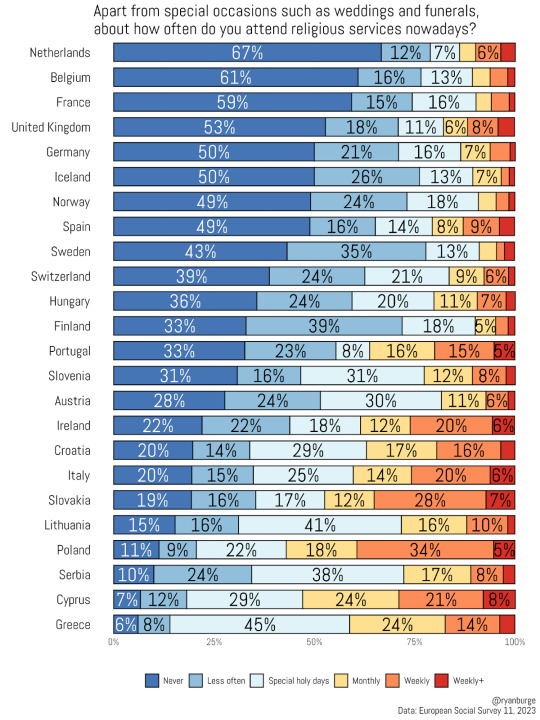
From an attendance perspective, the Netherlands is the least religious country in the dataset. About two-thirds of the Dutch never attend religious services and nearly 80% are attending less than once a year. In comparison, just 1 in 10 are at a house of worship on a weekly basis. But, there’s another way to look at this - what country has the lowest share of weekly attenders? The answer is Iceland at 3%, followed by Sweden, Norway, and Finland. It shouldn’t take a deep knowledge of geography to know what those countries have in common - religion is nearly extinct in Scandinavia.
What about the other end of the religious behavior spectrum? Well, in Poland 39% of folks are weekly attenders - that’s the highest of this group of 24. They are followed by Slovakia (35%), Cyprus (29%), Ireland and Italy (both at 26%). But notice in the graph that Greece had the lowest share of never attenders at just 6%. That’s an interesting country because nearly half the respondents say that they only attend on special holy days. The only other countries even close to that are Serbia and Lithuania.
Let me compare the answers to this question from the most recent wave of the ESS to the prior collection period which came from 2018 and 2020. This should give us a sense of whether religious behavior is still shifting in Europe in the last few years.

I was pretty surprised to see just how little had changed in a bunch of these countries over the last five or seven years. In 15 countries out of 24, the share of never attenders changed by no more than three percentage points between the two surveys being fielded. So, stasis is really the norm here. This may point to the fact that secularization has really run its course through most of the continent. Which means that what comes next for religion in Europe is really hard to predict.
What about the big movers? Well, in Belgium the share of never attenders rose from 52% to 61%. That’s clearly the largest shift among any of the countries in the dataset. In France, never attenders rose by four points and it was six points in Germany, going from 44% in 2018 to 50% in 2023. There was also a significant jump in the Netherlands (five points) and Norway (six points). I could find four cases where this percentage went down: Hungary, Ireland, Italy, and Serbia. But I am not ready to say that any countries are seeing a big revival as the differences aren’t that large.
Remember that idea of a reference case? Well, I wanted to compare the United States to Europe when it comes to the share of weekly church attenders. This is comparing all fifty states (and D.C.) with the 24 countries included in the most recent version of the European Social Survey.
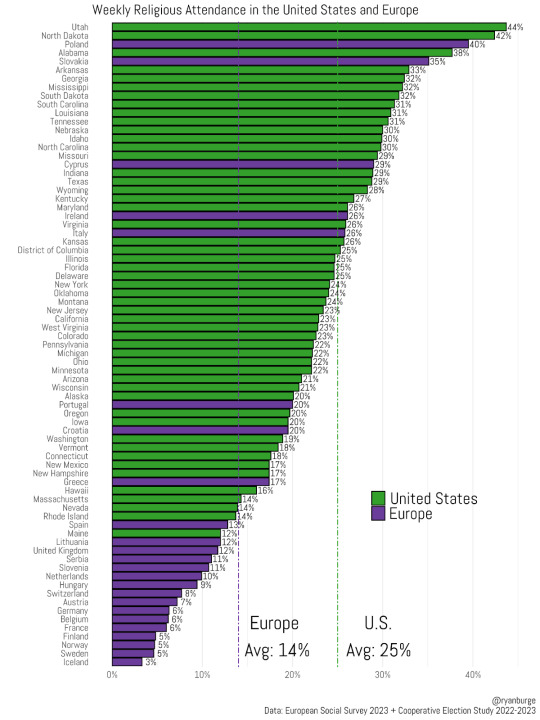
The first thing to point out is that when I made this graph in a prior post the average weekly attendance rate for Europe was 14% and it was 25% in the United States. Guess what? That hasn’t changed in the latest data. So, it looks like religious decline has slowed significantly.
From this angle, the most religious of the bunch is Utah with 44% of folks being weekly attenders. That’s followed by South Dakota at 42%. Then we have the first European country to show up - Poland at 40%. That’s followed by Alabama at 38% weekly attendance and then Slovakia at 35%. Then there’s a huge sea of green - meaning a whole bunch of American states. We don’t see another European country appear until we get to Cyprus, which is about as religious as Missouri, Indiana, or Texas.
You can clearly see that the bottom of this graph is dominated by Europe. The least religious state in this data is Maine - 12% never attenders. Then you have fifteen European countries. So, while Maine may seem pretty secular from an American perspective, it would certainly be a middle of the pack country if it were in Europe. So, it really depends on your frame of reference.
But religious attendance is just one part of the equation. What about religious affiliation?
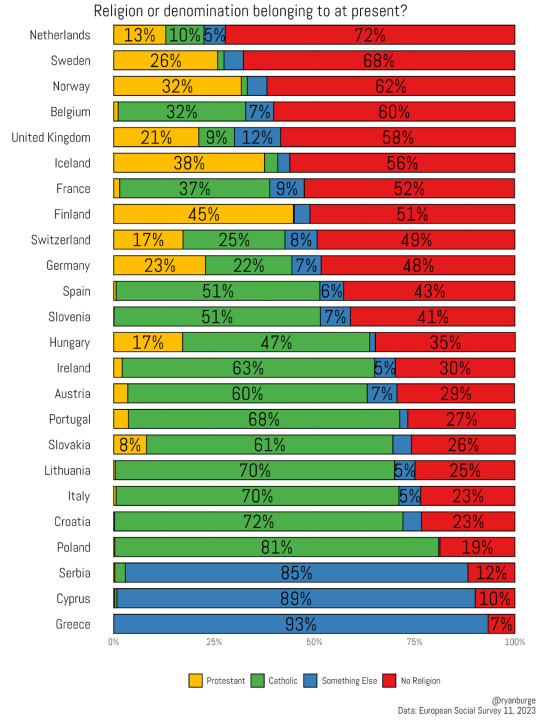
Again, the Netherlands leads the way on this metric, too - 72% of the Dutch have no religious affiliation. Remember that 67% of them never went to religious services, either. So, it’s safe to assume that 7 in 10 people living in the Netherlands have nothing to do with religion. Then, there are a bunch of Scandinavian countries with Belgium and the United Kingdom thrown into the mix too.
There are quite a few countries in Europe that are majority Christian, though. For instance, over 60% of Ireland are Catholic. That’s also the case in a bunch of other places like Austria, Portugal, Slovakia. And it’s above 70% in Lithuania, Italy, Croatia and Poland. For Serbia, Cyprus, and Greece, they are 85% Orthodox Christians. Using this measurement, the most religious country in Europe is Greece with just 7% who are non-religious. But on the other hand only 17% of Grecians are weekly attenders. So a lot of belonging without behavior.
Let’s compare the share who are non-religious in the United States versus Europe. I know this is going to seem impossible after just glancing at this graph but the median for both Europe and the United States for the share who are non-religious is 39%.

The issue here is pretty easy to spot based on the colors - Europe is incredibly bimodal on this metric. That means that there are a whole bunch of countries at the very top of the scale and the very bottom. For instance, there are six countries with a higher share of nones than any state in the United States. But of the 13 countries at the bottom of the graph, 11 of them are from the European continent. So, it’s a tale of a whole bunch of very secular countries compared to a whole bunch of really religious countries on the European continent.
North Dakota has the lowest share of nones in the United States at 22%. But that’s bested by Poland, Serbia, Cyprus and Greece. While Maine is the most secular state in America, it’s still ten points more religious than Sweden or the Netherlands. From this angle, I think it’s fair to say that the modal country in Europe is probably Slovenia. It falls nicely in the middle of the range of values. There’s no doubt in my mind that it’s harder to make broad claims about the religiosity of Europe compared to the religiosity of the United States. There’s just a ton more variation in the ESS.
Now let's combine behavior and belonging metrics. This is the share of each country that is weekly attending Christians. I think this does a pretty good job of showing the stark differences between the two continents.

Now we see quite a bit of variation across the top of the graph. Utah has the highest percentage of weekly attending Christians at 40%, but that’s followed closely by Poland at 39%. But then it goes back and forth between the United States and Europe. Then, of course, there’s a huge run of states. The U.S. basically makes up the entirety of the middle portion of the graph. I think from this analysis, the best comparison for the average American is Ireland or Italy. In both cases, about 24% are weekly attending Christians. That’s right in line with a whole bunch of states from various regions of the country.
But then, the bottom of the graph is just all Europe. You have 14 European countries where the share of the population who are weekly attending Christians is in the single digits. That’s not true of any state. The closest is Maine and Nevada at 10% each, but then there’s a bunch of states clustered between 12% and 17%. Of course, the least Christian countries are in Scandinavia but you also have France, Belgium, and Germany all at 5% or below, too.
There’s a lot to chew on here. Religion in the United States is certainly more normally distributed than what we see in Europe. In the ESS, it seems like there’s a whole bunch of fairly religious countries but also an even larger number of very secular countries, too. There’s just a lot more regional variation in Europe than the United States. Yes, the American South is more religious than New England. But the difference between South Carolina and Maine is only 18 points. Comparing Iceland to Poland, the gap is twice as large.
But I also think it’s fair to say that secularization has largely stopped in Europe, too. That’s certainly the case when it comes to attendance. I think a fair assumption is that most countries have bottomed out and won’t continue to go down from here.
Again, the operative question in doing this kind of word is: compared to what? If you compare Poland to Maine, then Europe is way more religious. But if it’s looking at Iceland next to Utah, then the picture reverses. Generally speaking, the United States is more religious than Europe. But that definitely glosses over a lot of nuance in the conversation.
#Ryan Burge#Europe#United States#religion#decline of religion#secularism#no religion#irreligion#leaving religion#empty the pews#religiosity#religion is a mental illness
4 notes
·
View notes
Text
techcarrot – Big Data Solutions Provider Company
techcarrot is a trusted partner in revolutionizing the way companies harness and utilize Big Data. With a proven track record of excellence, we are the driving force behind businesses that thrive in the data-driven era. A few of our strengths include:
Unparalleled Expertise: Our team of data scientists, engineers, and analysts leverage years of industry experience to tailor solutions that fit your unique needs. We cover everything from data collection and storage to advanced analytics and actionable insights.
Innovative Solutions: At techcarrot we understand that every business has its own challenges and goals. That's why we craft innovative, customized strategies that unleash the potential of your data. Whether it is predictive modeling, real-time analytics, or AI-powered insights, our solutions are designed to empower your decision-making process.
Data Security: We recognize that data is critical to your business, and its security is non-negotiable. With cutting-edge encryption, robust access controls, and vigilant monitoring, we ensure your data remains safe from threats.
Scalability: As your business grows your data also increases. Our Big Data solution & consulting services are built with scalability in mind, allowing you to seamlessly expand your data capabilities. We have the infrastructure and expertise to support data even in terabytes or petabytes.
Global Impact: Our solutions have transformed businesses across industries, enabling them to make smarter decisions, optimize operations, and drive innovation. Join our network of satisfied clients who have turned their data into a strategic asset.
Collaborative Approach: We work closely with you to understand your challenges, goals, and aspirations. Through open communication and collaboration, we ensure that our solutions align perfectly with your vision.
Don't miss out on the Big Data revolution. Choose techcarrot as your partner for all your data requirements as we are the best Big Data Solution Providers Company. Contact us today!
#big data consulting services in Dubai#Big Data Analytics Company in Dubai#Big Data Solution Providers Company in Dubai#big data#data visualization services in dubai#data intelligence company dubai
0 notes
Text
pages 13-20. I've got 8 more pages done but this is long enough. you can read the rest on the website <3 transcript at the end. also minor nsfw warning for the last page
Pages 1-8 / Pages 9-12


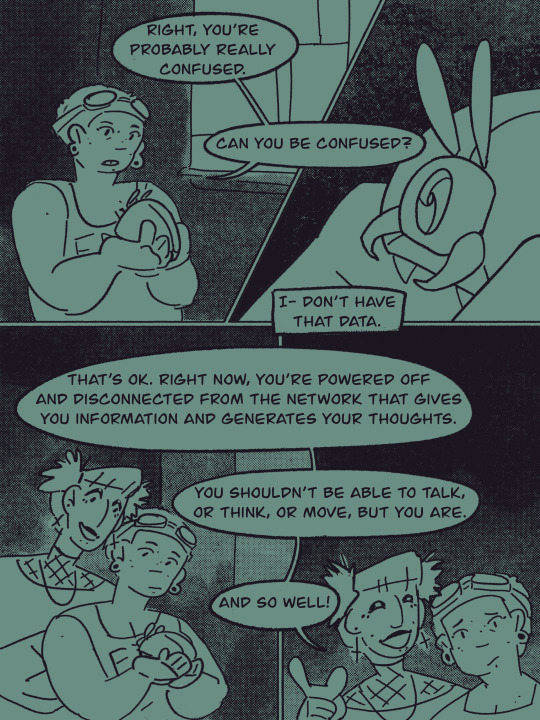




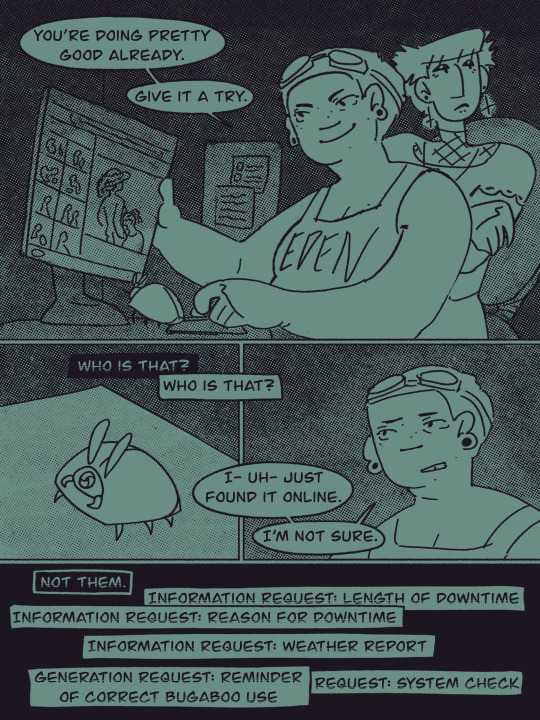
Page 13, panel 1. Memento peaks out the open window, as Tally and Sylvia talk off screen. Sylvia: This is huge! We need to call Dr. Heron. Tally: No, not yet. It could be unstable, I need to fine tune the formula.
Panel 2. As Memento creeps outside, a shadow looms over it, source unseen. Sylvia: The formula works, It's- Tally: It might break at any minute. We don't know how it reacts to stress.
Panel 3+4. The source of the shadow is shown, it's a pigeon. It looks down at Memento. Sylvia: Which is why we need to show them now before it does!
Page 14, panel 1+2. A flock of pigeons descend on Memento, pecking it. It looks distressed. Tally: We'd need to take it to them, it's too delicate to transport... Sylvia: So- ah, shit. You're right, not yet.
Panel 3. Memento flies back inside, into Tally's hands. Tally looks suprised. Tally: If it does break down, at least- Memento!
Page 15, panel 1+2. Shot reverse shot as Tally cups Memento in her hands. Tally: Right, you're probably really confused. Can you be confused? Memento: I- don't have that data.
Panel 3+4. Sylvia pops in from behind Tally. She looks cheerful, whereas Tally is more worried. Sylvia: That's ok. Right now, you're powered off and disconnected from the network that gives you information and generates your thoughts. You shouldn't be able to talk, or think, or move, but you are. And so well!
Page 16, panel 1. Memento hops back from Tally's hand, afraid. Memento: Tampering with your bugaboo will void your warranty and make you ineligible for Astrocare services.
Panel 2. Sylvia laughs. Sylvia: Ha, yeah, I voided that ages ago.
Panel 3+4. Memento: We recommend you discard your bugaboo and purchase a replacement- Tally interrupts, upset: What? No way, we're not getting rid of you. You're incredible. Memento: -as its functioning may be impaired, making it unable to provide sufficient personal and medical assistance. Tally: Stop it.
Panel 5. Tally caresses a hand against Memento's shell body. Tally: I don't need you to do that. That's not what you're for. Memento: My function is to help you. I can't do that without network access.
Page 17, panel 1 .Tally paces the room, lost in his imagination. Tally: You have a new function. You’re going to help so many more people…
Panel 2. She stops, interrupted by Memento. Memento: How do I do this?
Panel 3. Memento looks from Sylvia to Tally, caught between them. It’s not sure what’s happening. Tally: We need to run more tests to make sure you’re working how we think you are. You’re moving fine, that’s good, and you seem to remember things. Sylvia: Do you mean the speech it gave? Tally: Right, it knows it’s a bugaboo.
Page 18, panel 1+2+3. Sylvia looks back at Memento from the top of her computer, suspicious. Sylvia: I’m actually worried about that, it sounded too artificial. Tally: You don’t think it’s using the neutronium? Sylvia: We need more proof. Reinforce our argument, it’s good for the report.
Panel 4. Tally snaps her fingers, eureka. Tally: In that case... I've got a good test.
Panel 5. Sylvia looks less than thrilled about whatever idea Tally's cooked up. Sylvia: Oh.
Page 19, panel 1. Wide shot of the room. Tally bumps shoulders with Sylvia. Sylvia: Do we really have to do that one? We can't put it in the report. Tally: Sure we can.
Panel 2. Tally takes over the computer, typing something as Sylvia looks away with crossed arms. Memento flies to the computer's desk to get a better look. Tally: Memento was my ears for ages. I know the things Astro won't let it say.
Panel 3. Sylvia rolls her eyes. Sylvia: Ugh.
Panel 4. Close up on the desk, Tally clicks something with a mouse. Tally: I'm going to show you some people, can you describe to me what they're doing? Memento: I am equipped with advanced visual recognition software, however, I cannot access that without my network.
Page 20, panel 1. Tally angels the monitor so Memento can see what she's pulled up. It's a picture of a person in a feathery hat with their back to the camera, receiving oral sex. Sylvia averts her eyes, while Memento studies it. Tally: You've been doing pretty good already. Give it a try.
Panel 2. Memento studies the image. All text boxes previously have had a green background with black text, but this one is reversed, black background with green text. It also has green lines running through it, indicating it isn't spoken dialog. Black box/"the angel", internally: Who is that? Memento: Who is that?
Panel 3. Tally looks away, suddenly uncomfortable. Tally: I- uh- found it online. I'm not sure.
Panel 4. Overlapping text boxes on a blank black background The angel, internally: Not them. Memento, internally: Information request: length of downtime. Information request: reason for downtime. Information request: weather report. Generation request: reminder of correct bugaboo use. [cut off] report: system check.
#mine#my art#my comic#original comic#web comic#this group of pages taught me that writing a script makes the dialog a little more interesting but the visuals a lot lot more boring#i'm used to writing for a very different mostly non-visual format. so it was a good lesson#the next pages get a lot more fun ;)
3 notes
·
View notes
Text
Satellites: Their Orbits, Tracking Systems, and Essential Uses

Satellites: Their Positions, Tracking, and Importance
Satellites have become an essential part of modern life, orbiting Earth and providing us with services ranging from communication and navigation to weather forecasting and space exploration. As of 2024, thousands of active satellites are circling our planet, each performing a specific role to enhance the quality of life on Earth. This article delves into the positioning of satellites, how they are tracked, what they track, and the significance of their roles.
Types of Satellite Orbits and Their Positions
Satellites are positioned in various orbits depending on their intended functions. These orbits determine how close the satellite is to Earth, how fast it moves, and what areas it covers.
Low Earth Orbit (LEO): Altitude: 180 km to 2,000 km Satellites in LEO include most Earth observation satellites, the International Space Station (ISS), and some communication satellites. These satellites are closer to the Earth, enabling them to capture high-resolution images. Functions: Used for imaging, remote sensing, and some communication purposes. Examples: ISS, Earth observation satellites like Landsat.
Medium Earth Orbit (MEO): Altitude: 2,000 km to 35,786 km Satellites in MEO are mainly used for navigation. This orbit offers a good balance between coverage and latency. Functions: GPS satellites and other global navigation systems. Examples: GPS, GLONASS, and Galileo satellites.
Geostationary Orbit (GEO): Altitude: 35,786 km above the equator Satellites in GEO move at the same rotational speed as Earth, meaning they stay fixed over one location on Earth. These are mostly communication and weather satellites. Functions: Used for television broadcasts, weather monitoring, and some types of communication. Examples: Weather satellites (GOES series), telecommunication satellites.
Highly Elliptical Orbit (HEO): Orbit shape: An elongated orbit with one point closer to Earth (perigee) and another point much farther away (apogee). Functions: Ideal for regions at high latitudes, providing prolonged coverage over areas like Russia and parts of Canada. Examples: Molniya satellites for communication in Russia.
How Satellites Are Tracked
The sheer number of satellites in space, combined with space debris, means tracking them is essential to avoid collisions and ensure their functionality. Ground stations and dedicated space agencies continuously monitor satellites. Several methods are used to track satellites:
Radar and Ground-Based Systems: Ground stations use radar to track satellites in LEO. These systems bounce radio waves off the satellite and measure the time it takes for the signal to return. By doing this repeatedly, they can track a satellite's location and speed.
Global Positioning System (GPS): Satellites in higher orbits like MEO or GEO are tracked using onboard GPS receivers. GPS helps calculate the satellite’s position and relay that data back to Earth.
Optical Tracking: Telescopes and cameras are used to visually observe satellites in higher orbits. This method is particularly useful for tracking objects that do not emit radio signals or need to be monitored for their physical characteristics.
Space Surveillance Networks: Agencies such as the U.S. Space Surveillance Network (SSN) and similar organizations in other countries continuously monitor satellites and space debris. They catalog objects and issue alerts for potential collisions.
What Satellites Track
Satellites are equipped with various sensors, cameras, and instruments to track a wide array of data on Earth, in space, and beyond:
Weather and Climate Data: Satellites such as NOAA’s GOES series monitor weather patterns, hurricanes, and long-term climate changes. They provide crucial data for meteorological services.
Earth Observation: Satellites like Landsat capture high-resolution images of Earth's surface. These images are used for mapping, agricultural planning, disaster response, and environmental monitoring.
Navigation Signals: GPS and other GNSS (Global Navigation Satellite Systems) satellites send signals that are used for navigation by smartphones, vehicles, ships, and airplanes worldwide.
Communication: Satellites facilitate global communication by relaying TV, radio, and internet signals across vast distances.
Space Exploration: Space telescopes like the Hubble Space Telescope track distant galaxies, nebulae, and black holes, helping scientists study the universe.
Military Surveillance: Many satellites are designed for defense purposes, tracking missile launches, military movements, or spying on potential threats.
Number of Satellites in Space
As of 2024, there are approximately 8,000 operational satellites orbiting Earth. The exact number fluctuates as new satellites are launched and old ones are decommissioned. Additionally, space agencies and private companies like SpaceX continue to launch large satellite constellations, such as Starlink, which alone has over 5,000 satellites in orbit for global internet coverage.
The Usefulness of Satellites
Satellites have become indispensable in modern life, serving a wide variety of purposes that impact everyday activities and critical global functions:
Key Functions of Satellites:
Communication: Satellites enable long-distance communication by transmitting data, television, and internet services. Without them, global broadcasting and real-time communication in remote areas would be impossible.
Navigation: Systems like GPS help millions of people navigate in real-time. They are also vital for the functioning of aviation, maritime travel, and even agricultural practices.
Earth Observation: Satellites provide high-resolution imagery of Earth, helping with disaster management, urban planning, agriculture, and environmental monitoring. For instance, they can track deforestation or observe glaciers' melting rates.
Weather Forecasting: Weather satellites provide the data needed for accurate predictions, storm tracking, and climate monitoring. This information is critical for preparing for natural disasters like hurricanes or floods.
Scientific Research and Exploration: Space telescopes and interplanetary satellites gather data on space phenomena, expanding our understanding of the universe. Satellites also conduct scientific experiments in the microgravity of space.
Defense and Security: Satellites are used for military surveillance, early-warning systems, and missile detection, playing a crucial role in national security.
Satellite Highlights in Brief:
Types of orbits: LEO, MEO, GEO, HEO, each serving different purposes.
Tracking methods: Radar, GPS, optical tracking, and space surveillance networks.
Data tracked by satellites: Weather, Earth observation, navigation signals, space exploration, and military surveillance.
Number of active satellites: Approximately 8,000.
Key roles: Communication, navigation, weather forecasting, Earth observation, scientific research, and defense.
In conclusion, satellites are essential tools for global communication, navigation, monitoring Earth's environment, and scientific discovery. As technology advances and the number of satellites continues to grow, their impact on our daily lives will only increase. Whether improving how we predict the weather, navigate through traffic, or explore the universe, satellites will continue to be a critical resource for humanity.
Go To How Satellites Work and What They Track
#satellite orbits#satellite tracking#satellite functions#low earth orbit#geostationary orbit#medium earth orbit#space technology#GPS satellites#communication satellites#weather satellites#Earth observation#satellite uses#satellite positions#how satellites work#space surveillance#satellite navigation#satellite networks#satellite importance#global navigation systems
7 notes
·
View notes